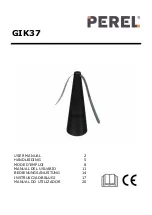
Defibrillator/Monitor Operator’s Manual
9 - 1
9
Noninvasive Pacing
9.1
Pacing Introduction
In the Pacer mode, the patient’s ECG is monitored through ECG lead set and pace pulses are delivered through
electrode pads. The electrode pads cannot be used to monitoring ECG rhythm and deliver pacing current at the
same time.
A white pace marker is shown on the ECG waveform each time a pace pulse is delivered to the patient. If pacing
in demand mode, white R-wave marker also appears on the ECG waveform until capture occurs.
During pacing, parameters except Resp continue to be monitored and parameter alarms remain active.
In demand mode pacing, a 3-lead or 5-lead ECG cable and electrodes are required to acquire ECG signal. Pace
pulses are delivered through electrode pads. However, the electrode pads cannot be used to monitor the ECG
and deliver pace pulses simultaneously.
NOTE
•
In the Pacer mode, arrhythmia analysis is supported and available arrhythmia alarms are asystole,
ventricular vibrillation and ventricular tachycardia.
9.2
Pacing Safety Information
WARNING
•
Heart rate displays and alarms function during pacing, but they can be unreliable. Observe the
patient closely while pacing. Do not rely on the indicated heart rate or heart rate alarms as a
measure of the patient’s perfusion status.
•
To avoid explosion hazard when pacing a patient who is receiving oxygen delivery, properly route
the oxygen delivery tube. Do not keep it close to the electrode pads.
•
Monitoring ECG alone is sometimes not enough to verify that the patient’s heart is providing cardiac
output.a patient’s response to pacing shall be verified by signs of improved cardiac output, such as:
a palpable pulse rate the same as the rate which pace pulses are being delivered, a rise in blood
pressure, and/or improved skin color.
CAUTION
•
Use of Pacer mode may be password protected. Make sure the operator knows and remembers the
password as defined in Configuration. Failure to enter correct password will prevent the delivery of
pacing therapy.
•
For treatment of patients with implanted devices such as permanent pacemakers or cardioverter-
defibrillators, consult a physician and the instructions for use provided by the device’s manufacturer
•
Prolonged noninvasive pacing may cause patient skin irritation and burns. Periodically inspect the
underlying skin and change ECG electrodes and electrode pads.
NOTE
•
If pacing is interrupted for any reason, the [Start Pacing] soft key must be pressed to resume pacing.
•
In the Pacer mode, you cannot change the patient’s internal paced status from the [ECG Setup]
menu.
•
In the case that electrode pads poorly contact the patient, the alarm “Pacer Stopped Abnormally”
and “Pads Off” may be presented.
•
Electrode pads are not an available choice for the source of ECG waveform in the Pacer mode.
Summary of Contents for BeneHeart D2
Page 1: ...BeneHeart D3 BeneHeart D2 Defibrillator Monitor Operator s Manual...
Page 2: ......
Page 16: ...10 Defibrillator Monitor Operator s Manual This page intentionally left blank...
Page 32: ...2 12 Defibrillator Monitor Operator s Manual This page intentionally left blank...
Page 64: ...6 6 Defibrillator Monitor Operator s Manual This page intentionally left blank...
Page 74: ...7 10 Defibrillator Monitor Operator s Manual This page intentionally left blank...
Page 86: ...10 4 Defibrillator Monitor Operator s Manual This page intentionally left blank...
Page 88: ...11 2 Defibrillator Monitor Operator s Manual This page intentionally left blank...
Page 108: ...15 2 Defibrillator Monitor Operator s Manual This page intentionally left blank...
Page 110: ...16 2 Defibrillator Monitor Operator s Manual This page intentionally left blank...
Page 114: ...18 2 Defibrillator Monitor Operator s Manual This page intentionally left blank...
Page 122: ...20 4 Defibrillator Monitor Operator s Manual This page intentionally left blank...
Page 150: ...24 8 Defibrillator Monitor Operator s Manual This page intentionally left blank...
Page 158: ...25 8 Defibrillator Monitor Operator s Manual This page intentionally left blank...
Page 182: ...D 2 Defibrillator Monitor Operator s Manual This page intentionally left blank...
Page 192: ...F 4 Defibrillator Monitor Operator s Manual This page intentionally left blank...
Page 200: ...G 8 Defibrillator Monitor Operator s Manual This page intentionally left blank...
Page 202: ...H 2 Defibrillator Monitor Operator s Manual This page intentionally left blank...
Page 204: ......
Page 205: ...Defibrillator Monitor Operator s Manual I 1 I Declaration of Conformity...
Page 206: ...I 2 Defibrillator Monitor Operator s Manual This page intentionally left blank...
Page 207: ......
Page 208: ...P N 046 010599 00 9 0...















































